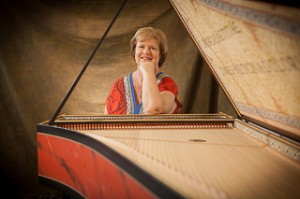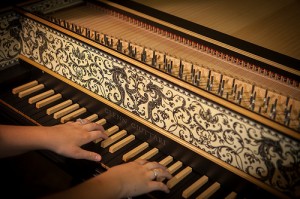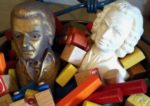Jack of all Trades
 When you teach in an outlying area, you have to keep quite a few irons in the fire. This semester I have renewed my relationship with the harpsichord. Ours is a Glenn Giuttari Flemish style instrument with a single manual and 2 choirs. It’s just plain awesome (despite the fact that she goes out of tune if you so much as sneeze).
When you teach in an outlying area, you have to keep quite a few irons in the fire. This semester I have renewed my relationship with the harpsichord. Ours is a Glenn Giuttari Flemish style instrument with a single manual and 2 choirs. It’s just plain awesome (despite the fact that she goes out of tune if you so much as sneeze).
Last week I was part of a day long harpsichord workshop at the college. Our Professor of Strings and History did a presentation on the ancestry and history of keyboard instruments. Our Keyboard Technician and Choral Professor Emeritus talked and demonstrated the mechanisms of both the harpsichord and our modern grand. I talked about baroque musical manners and did two masterclasses.
The classes were a blast. Students ranged from middle school to college age. Repertoire ranged from simple Bach Preludes, to short pieces by Leopold Mozart, to Bach Preludes and Fugues, to Scarlatti Sonatas. I decided from the get go that the purpose of the class was not performance but experiencing a new-old instrument. I made sure that all the students were prepared to play with the score. It was enough pressure to play on an unfamiliar instrument with white keys where the blacks should be. We didn’t need to add memory on top of all that.
At the beginning of the session, we did a short activity I call Prediction/Reality Check. Each student made 5 predictions about what it would be like to play the harpsichord and then tried out their piece. I told them all that this wasn’t about a missed Bb- it was about getting to touch history. After each student played their piece on the harpsichord then they played a little of their piece on the grand piano and we talked their predictions and about the difference in the instruments. Once they were comfortable, we started the actual Masterclass lessons.
And in the process, something really astounding happened.
The student’s ears began to open. Because they didn’t have dynamics or sheer power to bring the music to life, they had to use techniques including detached notes, slurs, over-holding. measured trills and rolled chords. One by one I watched as a look of wonder came over their faces as they realized the impact that these small details could have. They became spontaneously creative and not at all shy about playing around with phrases to see which way was their favorite.
When they took the music back over to the piano, they confidently decided what they liked and made changes accordingly. Some found that they didn’t need all of the power and dynamics they had formerly used. Most of them wanted to use a little pedal to imitate the harpsichord sound more closely. Our class on the conventions of the harpsichord ended up including a discussion of half, quarter, and vibrato pedaling.



